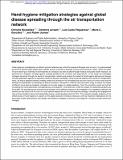Hand‐Hygiene Mitigation Strategies Against Global Disease Spreading through the Air Transportation Network
Author(s)
Nicolaides, Christos; Avraam, Demetris; Cueto-Felgueroso Landeira, Luis; Gonzalez, Marta C.; Juanes, Ruben
DownloadSubmitted version (1.404Mb)
Open Access Policy
Open Access Policy
Creative Commons Attribution-Noncommercial-Share Alike
Terms of use
Metadata
Show full item recordAbstract
The risk for a global transmission of flu-type viruses is strengthened by the physical contact between humans and accelerated through individual mobility patterns. The Air Transportation System plays a critical role in such transmissions because it is responsible for fast and long-range human travel, while its building components—the airports—are crowded, confined areas with usually poor hygiene. Centers for Disease Control and Prevention (CDC) and World Health Organization (WHO) consider hand hygiene as the most efficient and cost-effective way to limit disease propagation. Results from clinical studies reveal the effect of hand washing on individual transmissibility of infectious diseases. However, its potential as a mitigation strategy against the global risk for a pandemic has not been fully explored. Here, we use epidemiological modeling and data-driven simulations to elucidate the role of individual engagement with hand hygiene inside airports in conjunction with human travel on the global spread of epidemics. We find that, by increasing travelers engagement with hand hygiene at all airports, a potential pandemic can be inhibited by 24% to 69%. In addition, we identify 10 airports at the core of a cost-optimal deployment of the hand-washing mitigation strategy. Increasing hand-washing rate at only those 10 influential locations, the risk of a pandemic could potentially drop by up to 37%. Our results provide evidence for the effectiveness of hand hygiene in airports on the global spread of infections that could shape the way public-health policy is implemented with respect to the overall objective of mitigating potential population health crises.
Date issued
2019-12Department
Sloan School of Management; Massachusetts Institute of Technology. Department of Civil and Environmental EngineeringJournal
Risk Analysis
Publisher
Wiley
Citation
Nicolaides, Christos et al. "Hand‐Hygiene Mitigation Strategies Against Global Disease Spreading through the Air Transportation Network." Risk Analysis 40, 4 (December 2019): 723-740 © 2019 Society for Risk Analysis
Version: Original manuscript
ISSN
0272-4332
1539-6924